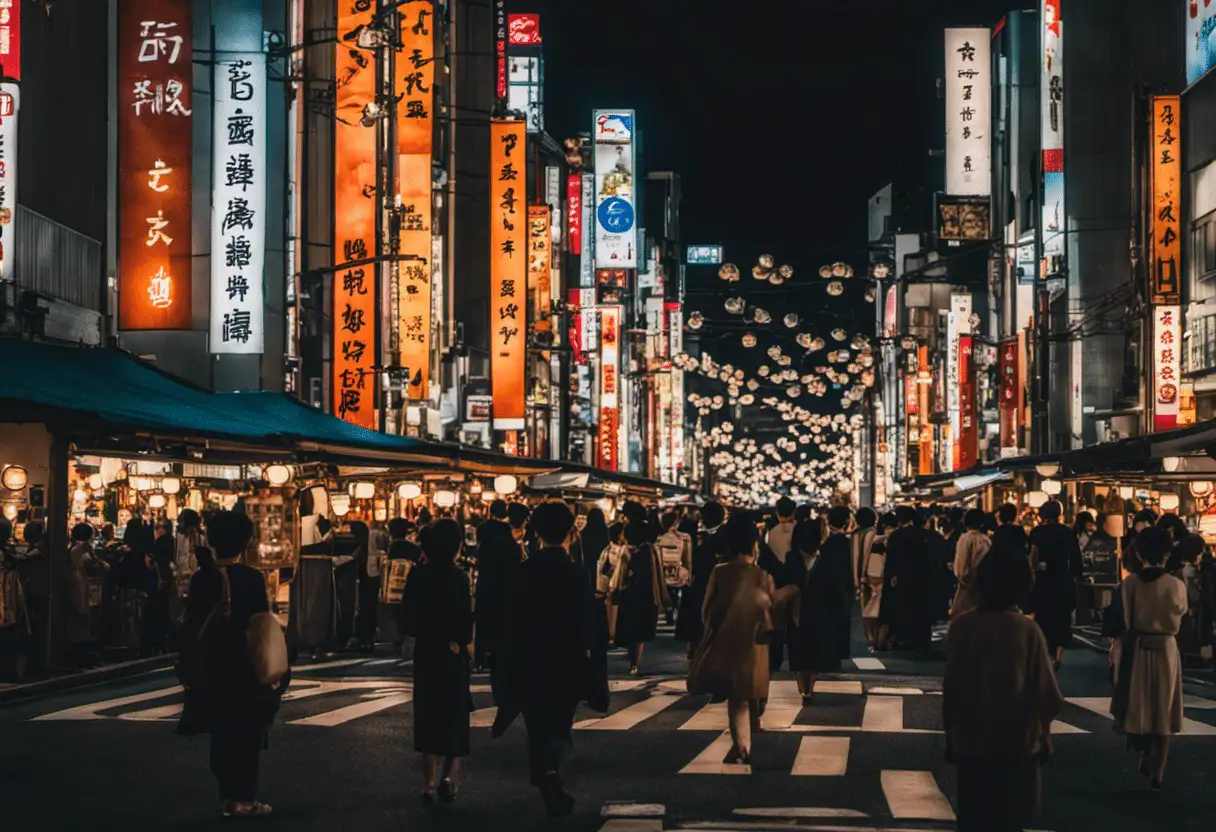10 Best Japanese Cultural Experiences
Have you ever wanted to immerse yourselves in the rich and diverse culture of Japan? Well, look no further! This article will take you to discover the 10 best Japanese cultural experiences.
There’s something for everyone, from the tranquil and elegant Traditional Tea Ceremonies to the intense and captivating Sumo Wrestling Matches.
So, grab your kimonos and get ready to explore ancient castles, learn the art of sushi making, and experience the power of taiko drumming.
Let’s dive into the wonders of Japan together!
1) Traditional Tea Ceremonies
We love attending the traditional tea ceremonies in Japan. These elegant and serene events provide a unique opportunity to immerse ourselves in Japanese culture and history.
The tea ceremony, known as ‘chanoyu’ or ‘sado,’ is a highly ritualized practice that dates back centuries. It’s a beautiful art form that celebrates harmony, tranquility, and mindfulness.
The ceremonies are typically held in specially designed tea rooms adorned with traditional tatami mats and sliding doors.
As we sit on the floor, we’re captivated by the graceful movements of the tea master as they carefully prepare and serve the matcha tea. We learn about the significance of each gesture and the deeper meanings behind the ceremony.
It’s a meditative experience that allows us to escape the hustle and bustle of modern life and find a sense of peace and freedom.
2) Sumo Wrestling Matches
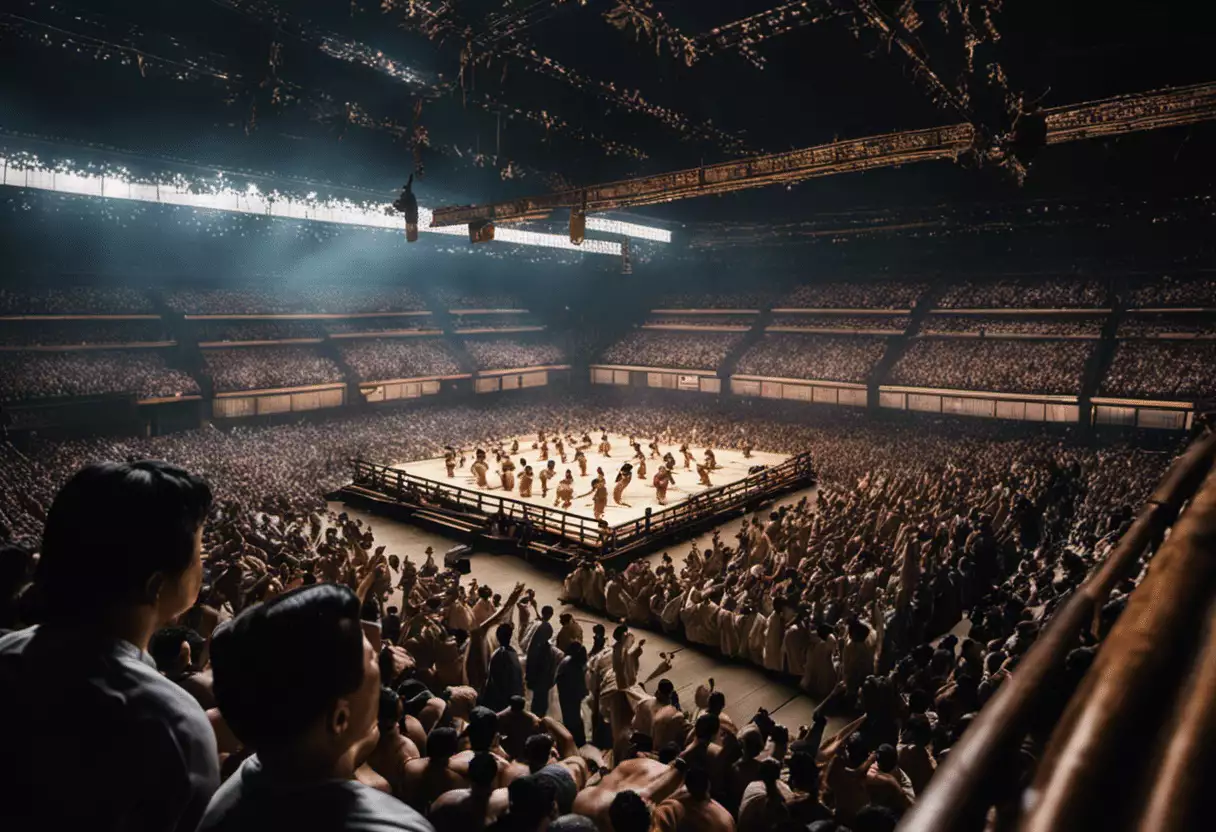
As we eagerly watch the sumo wrestling matches, we’re amazed by the sheer strength and skill displayed by the wrestlers. Sumo, Japan’s national sport, is a centuries-old tradition that captivates locals and tourists alike.
The wrestlers, known as Rikishi, are larger-than-life figures who dedicate their lives to this ancient art form. In the dohyo, the sumo wrestling ring, they engage in intense battles of power and strategy.
As we witness their bouts, we’re drawn into a world where tradition and athleticism collide. The Rikishi’s disciplined training and strict lifestyle are evident in every move they make.
Sumo wrestling isn’t just a sport; it’s a reflection of Japan’s rich cultural heritage and the indomitable spirit of its people.
3) Exploring Ancient Castles
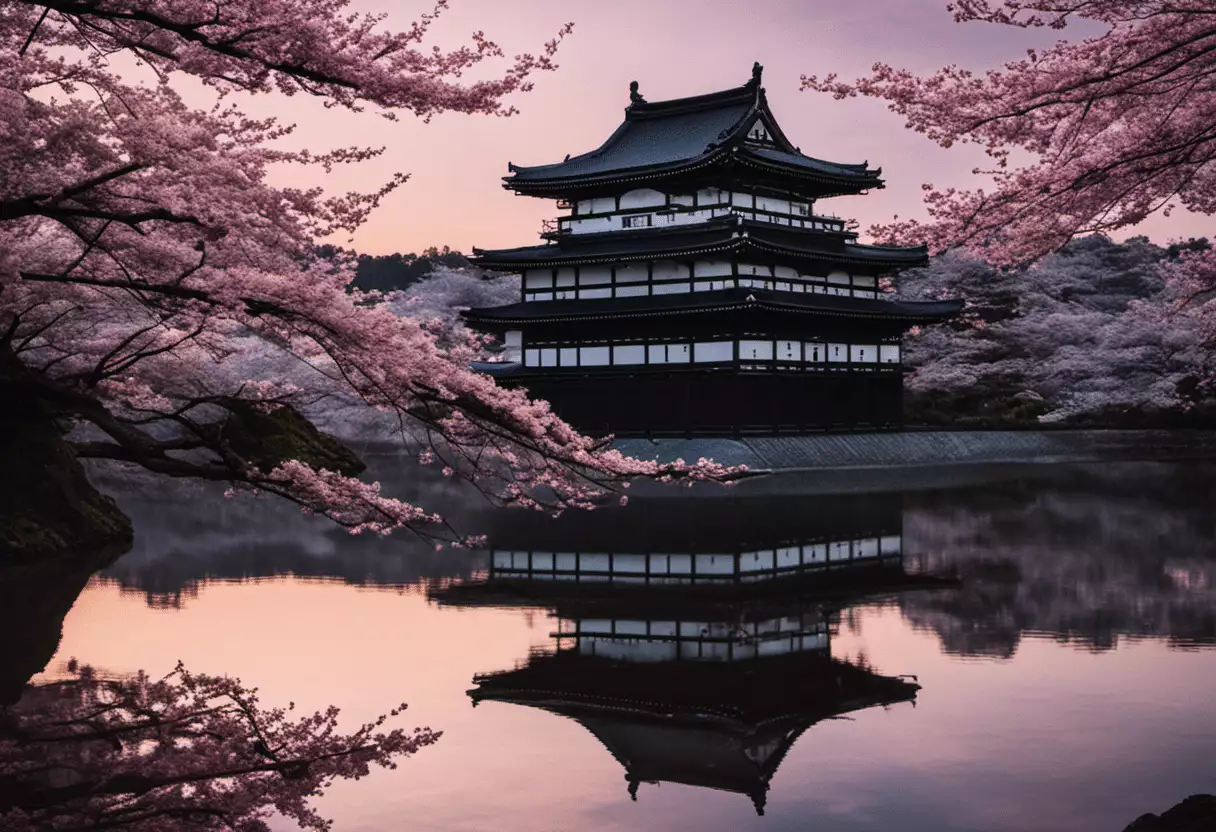
When we explore ancient castles, we’re transported back in time and can witness these remarkable structures’ historical significance and preservation.
These castles’ architectural marvels and designs astound us, showcasing the craftsmanship and ingenuity of the past.
Exploring ancient castles allows us to immerse ourselves in the rich cultural and educational significance of these landmarks, providing a deeper understanding of the history and traditions of the region.
Historical Significance and Preservation
These magnificent structures serve as a window into the past, allowing us to glimpse the lives and cultures of those who came before us.
The meticulous preservation of these castles is a testament to preserving our history and heritage.
From the stone walls to the intricate artwork, every aspect of these castles tells a story. The efforts to restore and maintain these historical sites ensure that future generations can continue to learn and be inspired by the rich history they represent.
As we wander through the grand halls and climb the towers, we can’t help but feel a sense of awe and respect for the individuals who dedicated their lives to preserving these cultural treasures. Through these preservation efforts, we can connect with our past and appreciate the freedom we have today.
Architectural Marvels and Design
Japanese architecture is renowned for its attention to detail and harmony with nature.
The traditional wooden structures, with their elegant lines and delicate carvings, showcase the skill of the craftsmen who built them. The castles not only served as defensive fortresses but also as symbols of power and prestige.
They were often strategically located, offering breathtaking views of the surrounding landscapes.
These architectural marvels are a testament to Japan’s rich history and cultural heritage. They provide a glimpse into the past, allowing us to understand the feudal era and the lifestyle of the samurai.
Here is a table that highlights some of the most famous castles in Japan:
| Castle Name | Location | Year Built | Notable Features |
|---|---|---|---|
| Himeji Castle | Himeji | 1333 | White exterior, complex defensive system |
| Matsumoto Castle | Matsumoto | 1504 | Black exterior, six-story main keep |
| Osaka Castle | Osaka | 1583 | Imposing architecture, beautiful gardens |
| Nagoya Castle | Nagoya | 1612 | Golden shachihoko, the impressive main keep |
Cultural and Educational Significance
Visiting these ancient castles provides us with a unique opportunity to learn about the cultural and educational significance of Japan’s history.
The castles, with their grand architecture and rich historical background, offer a glimpse into Japan’s feudal past and the lives of the samurai warriors.
Here are some key takeaways from exploring these cultural treasures:
- Cultural Significance: Castles served as symbols of power and authority, showcasing the wealth and strength of the ruling clans. They were centers of culture and art, housing beautiful gardens, tea houses, and traditional artworks.
- Educational Significance: Exploring the castles allows us to understand the strategic military tactics employed during battles and sieges. It offers insight into the hierarchical social structure of feudal Japan and the roles and responsibilities of the samurai.
4) Zen Meditation
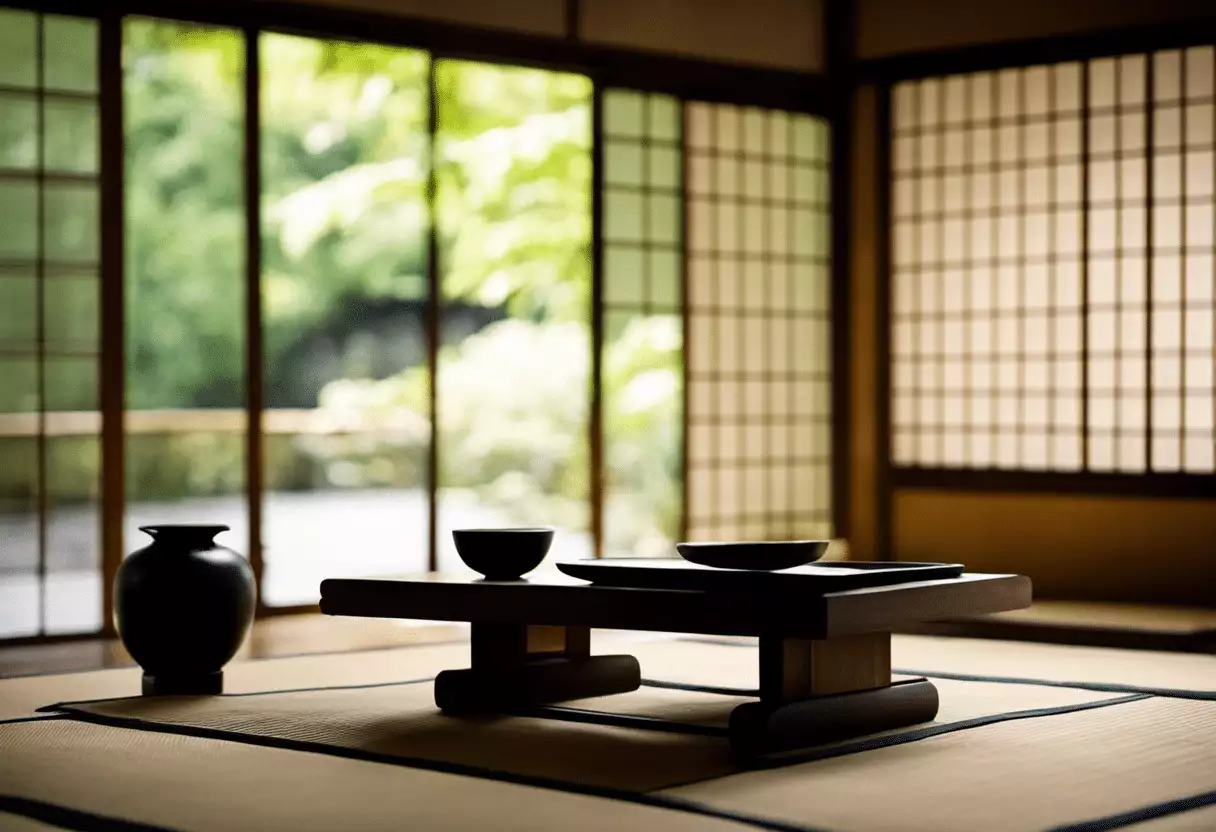
Zen meditation is a practice that allows us to find inner peace and clarity. It offers numerous benefits, such as reducing stress, increasing self-awareness, and improving overall well-being.
Benefits of Zen Meditation
Meditation enhances mindfulness and reduces stress levels, promoting overall well-being. It’s a practice that allows us to quiet the mind, focus on the present moment, and cultivate a sense of inner peace.
The benefits of Zen meditation are numerous and have been recognized for centuries.
Here are a few key advantages:
- Improved mental clarity and focus: Zen meditation helps clear the mind of clutter and distractions, allowing us to concentrate better on the task. It enhances our ability to stay present and fully engaged in the moment, leading to increased productivity and efficiency.
- Reduced stress and anxiety: Through regular practice, Zen meditation helps to calm the nervous system and release tension from the body. It promotes deep relaxation, reducing the harmful effects of chronic stress and anxiety on our physical and mental well-being.
In a world that values freedom and self-expression, Zen meditation offers a powerful tool for finding inner peace and balance amidst the chaos of daily life.
Techniques for Zen Meditation
Let’s explore different techniques to deepen our Zen meditation practice and achieve a state of inner calm and tranquility.
- One technique that can help us is focusing on the breath. By bringing our attention to the sensation of inhaling and exhaling, we can anchor ourselves in the present moment and quiet the mind.
- Another technique is body scanning, where we systematically bring awareness to different body parts, observing any sensations or tensions that arise. This practice helps us develop a deeper connection with our physical selves and promotes relaxation.
- Visualization is also a powerful tool in Zen meditation. We can imagine ourselves in serene natural environments or visualize positive affirmations to cultivate peace and positivity.
- Lastly, incorporating walking meditation into our practice can provide a refreshing change of pace. Mindfully walking, paying attention to each step and the sensations in our feet, we can find a sense of grounding and presence.
5) Samurai Swordsmanship
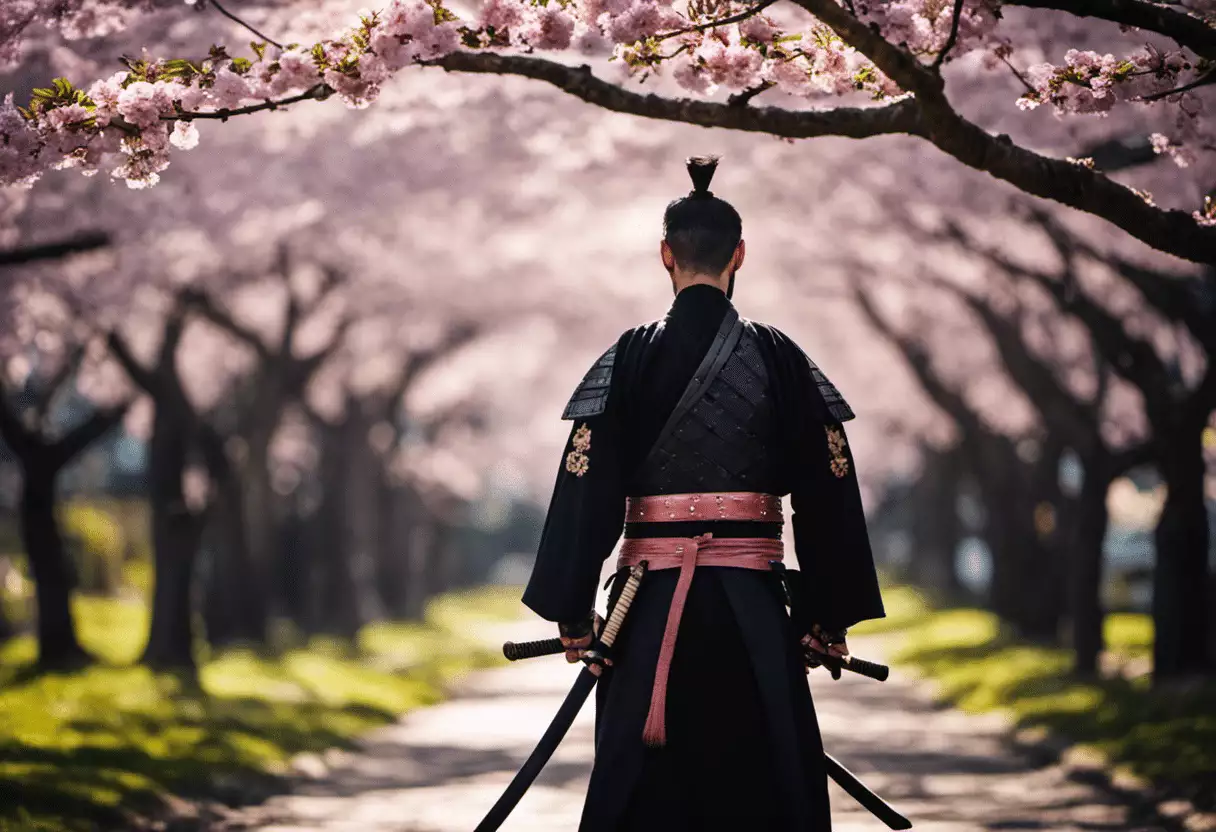
Have any of you tried practicing samurai swordsmanship? It’s a fascinating martial art that has deep roots in Japanese culture.
Samurai swordsmanship, known as kenjutsu, isn’t just about wielding a sword but encompasses a philosophy and way of life.
Here are some exciting aspects of samurai swordsmanship:
Techniques:
- Laido: This focuses on drawing the sword quickly and smoothly from its sheath, striking the opponent, and then re-sheathing the sword.
- Kenjutsu: This is the practice of sword fighting techniques, including strikes, blocks, and footwork.
Mindset:
- Bushido: The samurai code of conduct emphasizing honor, loyalty, and self-discipline.
- Zanshin: The state of being fully present and aware, even after the fight.
Samurai swordsmanship isn’t just about physical prowess and cultivating a strong mind and spirit. It teaches discipline, focus, and respect for oneself and others.
6) Geisha Performances
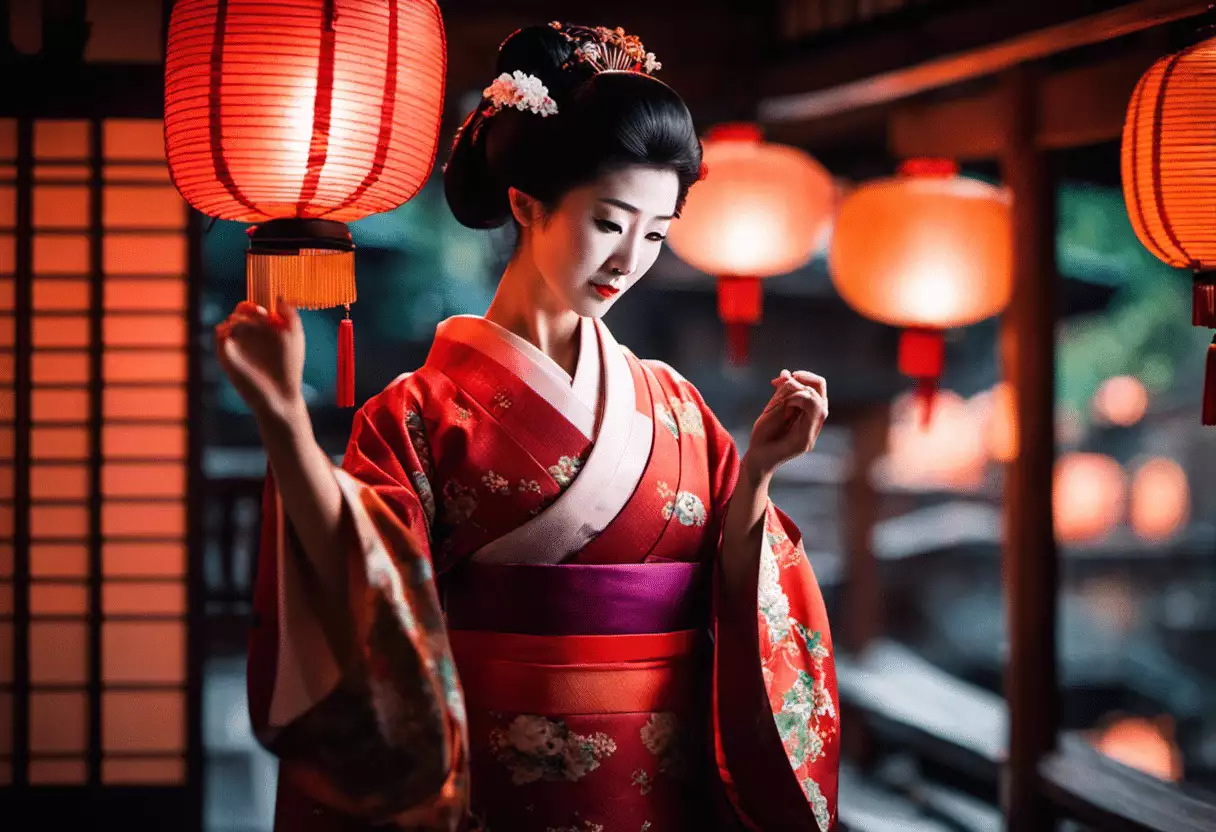
We should attend a geisha performance, as they’re known for their exquisite artistry and graceful movements.
Geisha, meaning ‘person of the arts,’ are traditional Japanese entertainers who’ve mastered skills in various performing arts such as dance, music, and poetry. These performances offer a unique glimpse into the rich cultural heritage of Japan.
Geisha are trained in traditional Japanese arts and spend years perfecting their craft. Their performances showcase their mastery of dance, accompanied by live music played on traditional instruments.
The graceful movements of the geisha, accompanied by the melodic sounds of the shamisen and the singer’s soothing voice, create an enchanting atmosphere.
Attending a geisha performance allows us to appreciate the beauty and elegance of their artistry, giving us a deeper understanding of Japanese culture and traditions.
7) Traditional Kimono Dressing
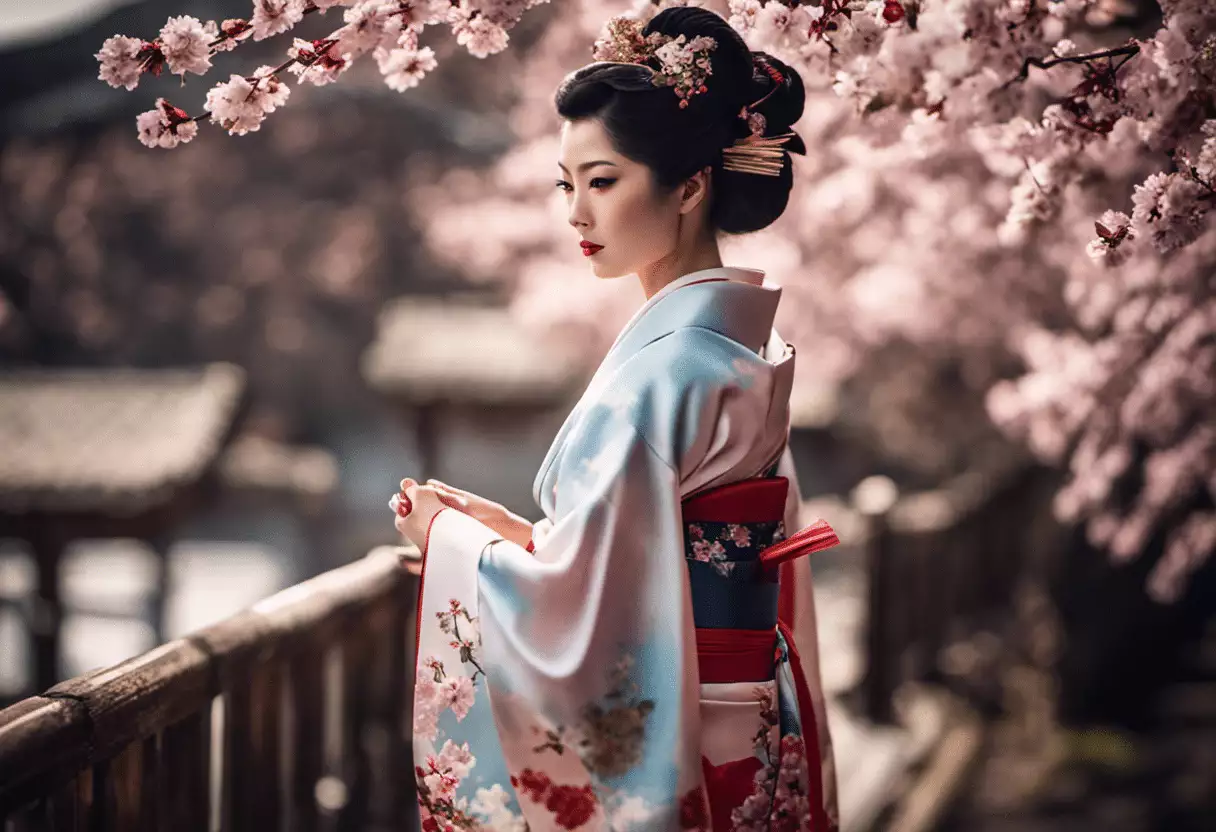
Traditional Kimono Dressing is a fascinating art form deeply rooted in Japanese culture.
The kimono is more than just a piece of clothing; it symbolizes tradition, spirituality, and social status.
Understanding the symbolism and meaning behind each kimono pattern and color is essential in appreciating the art of kimono dressing.
Kimono Symbolism and Meaning
Let’s explore the symbolism and meaning behind kimonos, diving into their rich cultural significance.
Kimonos, traditional Japanese garments, hold deep symbolism and reflect the values and traditions of Japanese culture. Here are some key aspects to consider:
- Traditional Patterns: Each pattern on a kimono holds a specific meaning, such as good luck, longevity, or prosperity. Common patterns include cherry blossoms, fans, cranes, and waves, each representing different aspects of life.
- Colors and Fabrics: The colors of kimonos also carry significance. For example, red symbolizes energy and vitality, while black represents formality and elegance.
Different fabrics, such as silk or cotton, are used for various occasions, with silk reserved for formal events.
Modern Kimono Fashion
The modern kimono fashion trend has been gaining popularity among fashion enthusiasts worldwide. With its elegant design and rich cultural heritage, the kimono symbolizes freedom and self-expression.
Designers have embraced this traditional garment and infused it with contemporary elements, creating a fusion of old and new.
The modern kimono can be found in various styles, from bold and vibrant patterns to minimalist and monochrome designs. It can be worn for casual and formal occasions, making it versatile and adaptable to different fashion tastes.
| Pros | Cons |
|---|---|
| Allows for creativity and self-expression | Can be expensive |
| Embraces cultural diversity | May require assistance to wear |
| Versatile and adaptable to different occasions | Limited availability in some regions |
| Represents a fusion of tradition and modernity | It may not suit all body types |
| Provides a unique and stylish fashion statement | Requires proper care and maintenance |
Kimono Etiquette and Customs
We should respectfully bow when receiving or returning an item wearing a kimono. This gesture is integral to kimono etiquette and customs, showing respect and gratitude.
In addition to bowing, there are other customs to keep in mind when wearing a kimono:
- Handling the Obi: The obi, or the wide sash that holds the kimono together, should be held with both hands when tying or adjusting it. This demonstrates care and attention to detail.
- Walking in a Kimono: When walking in a kimono, it’s important to take small, delicate steps. This not only preserves the fabric but also maintains an elegant appearance.
8) Japanese Calligraphy
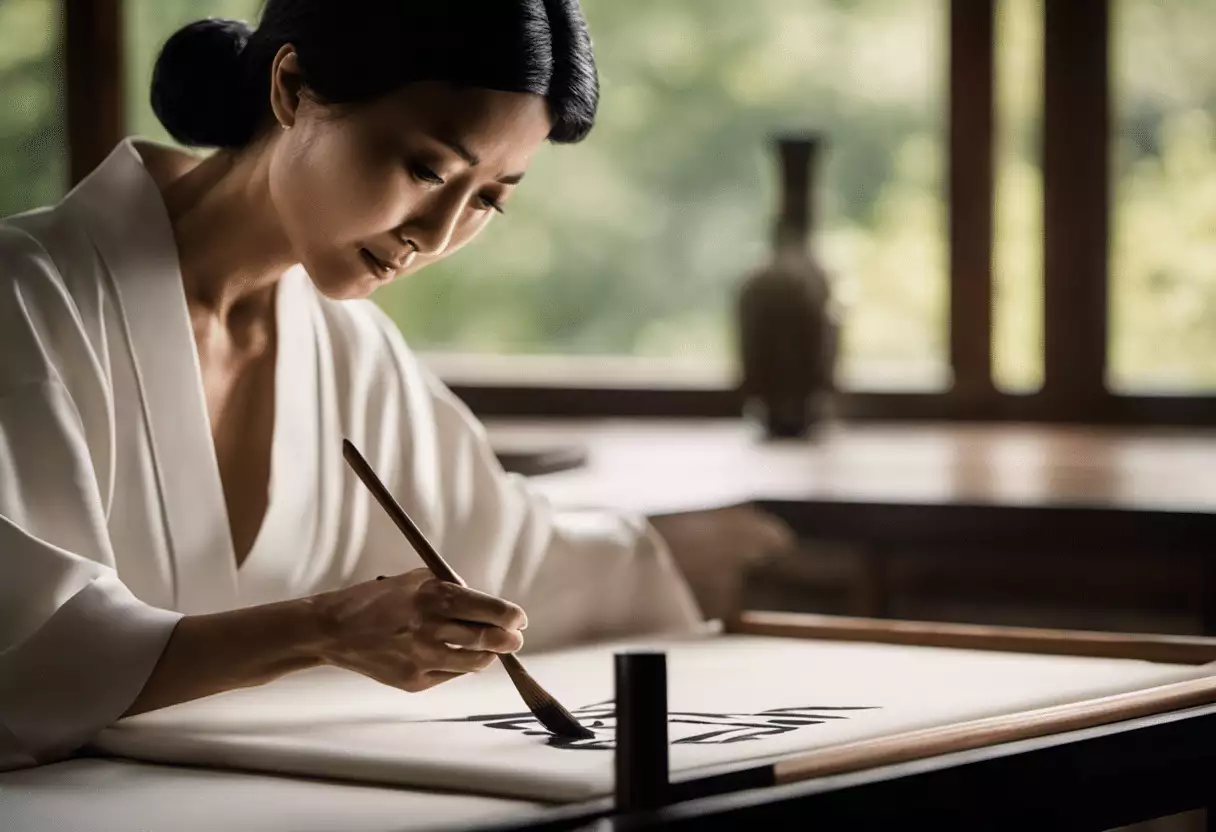
We love the elegance and precision of Japanese calligraphy. It’s a proper art form that requires years of practice and dedication to master.
The strokes are carefully executed with a brush and ink, creating beautiful characters that convey meaningful messages. The beauty of Japanese calligraphy lies not only in the outcome but also in the process itself.
Each stroke is deliberate, reflecting the artist’s mind and emotions. The simplicity of the brush and ink allows for a sense of freedom and creativity, as every stroke can be unique and expressive.
Japanese calligraphy isn’t just about writing characters; it’s about capturing the essence of a moment, expressing oneself, and finding inner peace. It’s truly a transformative experience that allows for self-expression and personal growth.
9) Sushi Making Classes
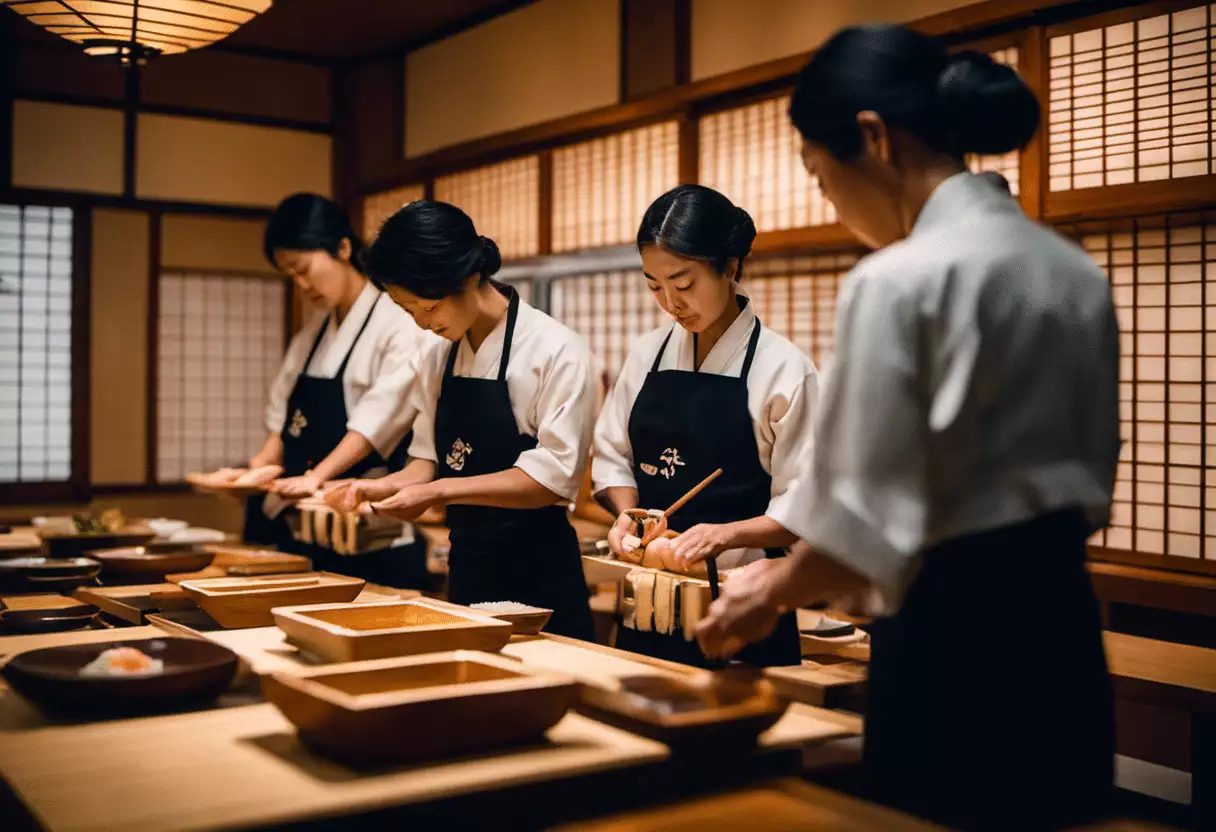
Since we’ve always wanted to learn how to make sushi, we signed up for a sushi-making class. It was a fantastic opportunity to delve into Japanese culinary traditions and gain hands-on experience.
A skilled sushi chef led the class and shared their expert knowledge. Here are some highlights from our sushi-making adventure:
- Ingredients: We learned about the essential components of sushi, including fresh seafood, vinegared rice, and seaweed. Discovering the importance of quality ingredients in creating authentic flavors was fascinating.
- Techniques: The chef taught us various methods, such as adequately slicing fish, rolling sushi, and molding rice. We practiced these skills under their guidance, honing our abilities each attempt.
- Presentation: Another aspect we explored was the art of sushi presentation. The chef emphasized the importance of aesthetics in Japanese cuisine, teaching us how to arrange sushi beautifully on a plate.
10) Taiko Drumming Performances
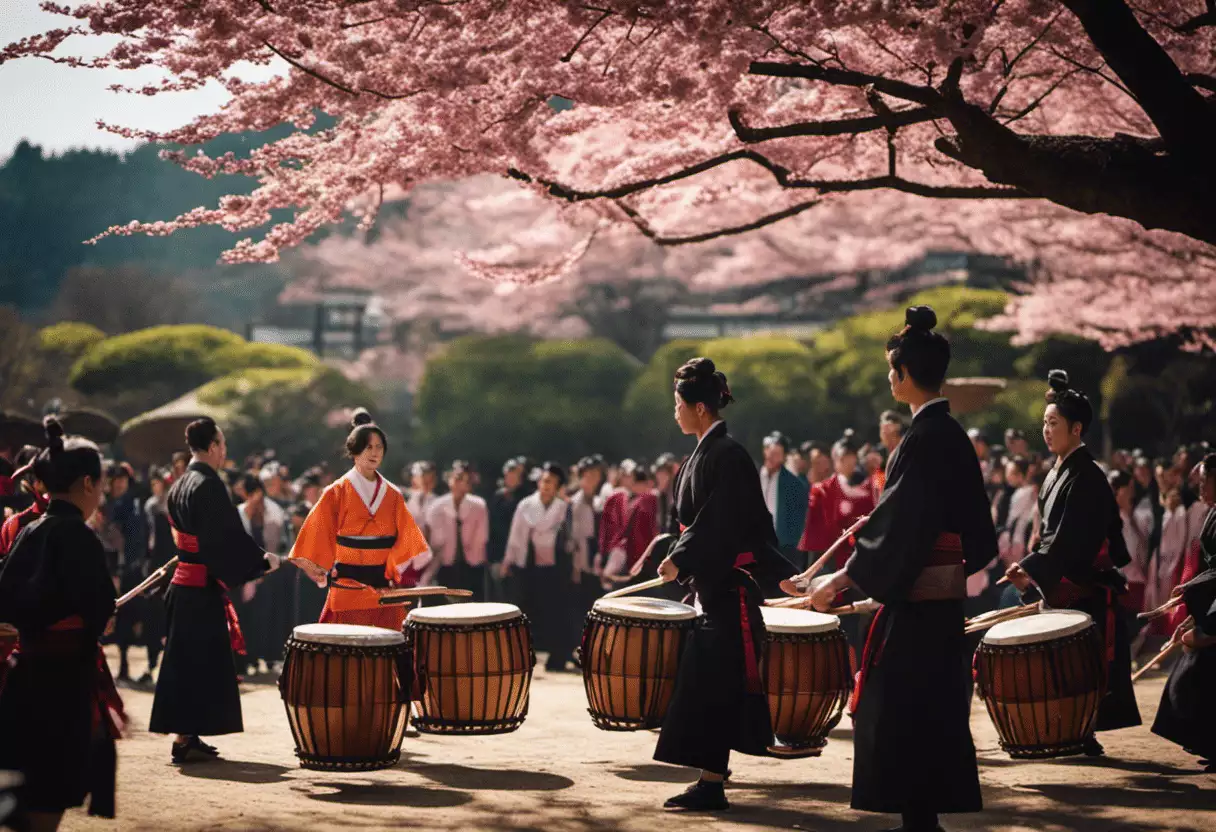
Attending a taiko drumming performance was mesmerizing – the thunderous beats and synchronized movements left us in awe.
The energy and passion exuded by the performers were palpable as they skillfully pounded on the massive drums with relentless force.
Each strike reverberated through the air, sending vibrations straight to our core. The rhythmic patterns and intricate choreography showcased the rich cultural heritage of Japan and captivated us from start to finish.
Taiko drumming is more than just a musical performance; it’s a form of expression and a means of storytelling. The performers, dressed in traditional attire, conveyed emotions and conveyed narratives through their powerful drumming.
The coordination and timing required for a flawless performance were truly impressive, as the group moved in perfect unison, seamlessly transitioning between different rhythms and tempos.
Beyond the sheer entertainment value, taiko drumming holds a deeper significance. It symbolizes unity, strength, and the power of community.
The pounding of the drums represents the beating heart of a collective spirit, bringing people together and igniting a sense of freedom and liberation. It’s a reminder of the resilience and indomitable spirit that resides within us all.
Attending a taiko drumming performance is a transformative experience that transports us to a different realm.
The thunderous beats awaken our senses, leaving us enthralled and uplifted. It’s a celebration of culture, artistry, and the freedom of expression. So, if you have the opportunity, don’t miss out on witnessing this mesmerizing display of talent and tradition.
Frequently Asked Questions
How Long Does a Traditional Tea Ceremony Typically Last?
A traditional tea ceremony typically lasts about one hour. It is a serene and meticulous practice that involves preparing and serving matcha tea and various customs and rituals.
What Are the Rules and Etiquettes to Follow During a Sumo Wrestling Match?
During a sumo wrestling match, specific rules and etiquette must be followed. These include the opening ceremony, how the wrestlers enter the ring, the ceremonial purifying ritual, and the techniques used in the match.
Are There Any Ancient Castles That Are Accessible to the Public for Exploring?
Yes, there are ancient castles accessible to the public for exploring. They offer a glimpse into Japan’s rich history and architecture. The experience is both educational and awe-inspiring.
How Does One Begin Practicing Zen Meditation and What Are Its Benefits?
To begin practicing Zen meditation, we can find a quiet space and assume a comfortable posture. The benefits of Zen meditation include stress reduction, increased focus, and a deeper sense of self-awareness.
Can Tourists Participate in Samurai Swordsmanship Classes?
Yes, tourists can participate in samurai swordsmanship classes. It offers a unique opportunity to learn about the samurai’s ancient art and experience firsthand Japan’s rich cultural heritage.
Conclusion
In conclusion, immersing ourselves in the rich cultural experiences of Japan allows us to step into a world where time-honored traditions come to life.
From the graceful movements of a tea ceremony to the thunderous clashes of sumo wrestlers, every moment is an opportunity to be captivated by the beauty and grace of Japanese culture.
Whether exploring ancient castles or mastering the art of sushi making, these experiences will leave an indelible imprint on our hearts and minds, forever connecting us to the vibrant tapestry of Japan.

